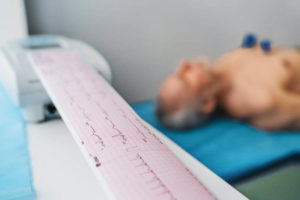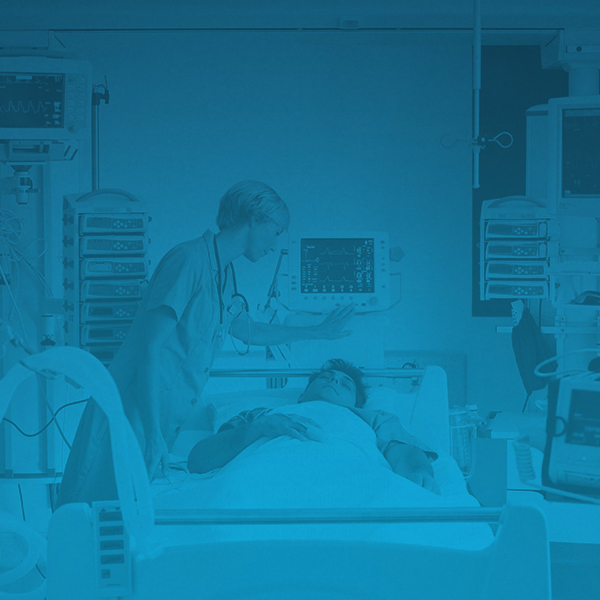How to Treat Pulseless Electrical Activity
How to Treat Pulseless Electrical Activity

by Greta Kviklyte
Life Saver, AMC
Co-authored by Kim Murray, RN, M.S.
posted on Dec 14, 2020, at 12:48 pm
Out-of-hospital cardiac arrests affect approximately 300,000 people in the United States each year. The survival rate among these patients is low, typically hovering around 8 percent. In-hospital cardiac arrests are also recorded in many patients Some patients with cardiac arrest present with pulseless electrical activity, or PEA. This type of presentation requires a specific approach in order to maximize survival rates.
We offer Online ACLS Certification and Renewal
What Is Pulseless Electrical Activity?
Pulseless electrical activity occurs when a patient has cardiac electrical activity but no pulse. This means that no mechanical contracts are occurring, despite organized electrical activity in the heart. The pulseless electrical activity includes any type of cardiac arrest rhythm that cannot be categorized as asystole, ventricular fibrillation, or pulseless ventricular tachycardia. Pulseless electrical activity was previously referred to as “electromechanical dissociation.”

It is important to note that cases of PEA can be broken down into two subcategories: pseudo-PEA and true PEA. Pseudo-PEA occurs when cardiac contractions are occurring, but they are not strong enough to create a palpable pulse. True PEA, on the other hand, involves no mechanical contractions in the heart at all. True PEA is more serious than pseudo-PEA.
Causes of Pulseless Electrical Activity
Pulseless electrical activity may occur because of any issue that inhibits the shortening of myocardial fibers, thus preventing mechanical contractions. Possible causes of pulseless electrical activity include ionic perturbations, metabolic acidosis, ischemia and hypoxia. Patients may experience PEA after a drug overdose, myocardial infarction, trauma, hypothermia, hypoglycemia, cardiac tamponade, pulmonary embolism, or sepsis.
Studies indicate that pulseless electrical activity accounts for as many as 40 percent of cardiac arrests in the hospital and as many as 40 percent of cardiac arrest events outside of the hospital.
Seriousness of PEA
Pulseless electrical activity is associated with a poor prognosis for patients. Studies show that only 2 to 5 percent of patients who experience PEA outside of the hospital will survive. The survival rate is even lower when PEA presents after countershock instead of as the initial rhythm.
Treating Pulseless Electrical Activity
The treatment recommendations for patients with pulseless electrical activity vary based on whether the patient is in the hospital or outside of the hospital at the time of the event, as well as the cause of the PEA.
PEA in the Hospital
When PEA is being treated in a hospital setting, the recommended course of action typically depends on the suspected cause of cardiac arrest. The 2010 American Heart Association Guidelines for Cardiopulmonary Resuscitation and Emergency Cardiovascular Care recommends that healthcare providers assess 10 different possible issues that could cause PEA when this type of cardiac arrest occurs. These issues are broken down into five H’s and five T’s.
The five H’s are:
- Hydrogen ion
- Hyperkalemia or hypokalemia
- Hypothermia
- Hypovolemia
- Hypoxia
The five T’s are:
- Thrombosis (cardiac)
- Thrombosis (pulmonary)
- Toxins
- Tamponade
- Tension pneumothorax
Regardless of the cause of PEA, the first step in treating this condition is always to begin chest compressions based on the advanced cardiac life support protocol. Epinephrine should also be administered every three to five minutes while the cause of the PEA is identified. After the factors contributing to the development of PEA have been identified, treatment of PEA typically involves reversing the cause of the event. The basic treatment recommendations for each of these potential causes of PEA are detailed below.
Hydrogen Ion (Acidosis)
Acidosis can be quickly confirmed with an arterial blood gas. If the patient is suffering from metabolic acidosis, the treatment may involve sodium bicarbonate administration. if the patient is suffering from respiratory acidosis, ventilation is the recommended treatment.
Hyperkalemia or Hypokalemia
Hypokalemia is a common electrolyte disturbance that can cause PEA when potassium levels drop to dangerous lows. Administration of potassium is recommended in cases of hypokalemia.
Hyperkalemia occurs when potassium levels are dangerously high. The treatment of hyperkalemia involves protecting the heart, shifting potassium into cells and taking steps to remove potassium from the body.
Hypothermia
Hypothermia occurs when body temperature drops to a dangerous level. When hypothermia is the cause of PEA, rewarming of the patient’s body is the recommended treatment to return temperature to normal.
Hypovolemia
Hypovolemia occurs when extracellular fluid levels in the body drop too low. This may occur for many different reasons, from vomiting to blood loss. The recommended treatment for hypovolemia involves infusion of blood products and/or warmed crystalloids. The root cause of hypovolemia should be addressed as well.
Hypoxia
Low oxygen levels can occur for many different reasons, including asthma, anemia, drowning and many other conditions. Ventilation and restoring oxygen levels is the best treatment for hypoxia.
Thrombosis (Cardiac)
Treating cardiac thrombosis usually involves an intervention designed to resolve the clot, such as primary percutaneous coronary intervention or coronary angiography.
Thrombosis (Pulmonary)
Most cases of pulmonary thrombosis begin with deep vein thrombosis. Possible treatments involve surgical removal of the clot, percutaneous mechanical thrombectomy and administration of fibrinolytics.
Toxins
A variety of different toxins can cause pulseless electrical activity. Some of the different types of toxins that may cause this condition include local anesthetics, tricyclic antidepressants, opioids and benzodiazepines. The treatment for pulseless electrical activity caused by a toxin will depend on the type of toxin responsible.
Tamponade
Cardiac tamponade occurs when the pericardial sac fills with fluid, leading to cardiac arrest. This condition can be treated by pericardiocentesis or thoracotomy.
Tension Pneumothorax
Tension pneumothorax occurs when air accumulates in the patient’s pleural space. Treating this condition requires needle compression and/or a thoracostomy.
PEA Outside of the Hospital
Treating PEA outside of the hospital typically involves following an established, generalized protocol regardless of the cause of the event. This means that the individual administering aid will follow the advanced cardiac life support protocol until the patient can be transferred to a setting where more intensive diagnostic and treatment services are available. Once these resources are available, ACLS protocols should be continued and epinephrine should be administered every three to five minutes until the cause of the PEA can be identified.
Learning Advanced Cardiac Life Support
Treating pulseless electrical activity both inside and outside of the hospital involves the use of Advanced Cardiac Life Support protocols. In order to ensure that you are up-to-date on the latest ACLS guidelines, as well as to comply with your employer’s requirements, you must keep up with ACLS certifications. However, if you are working as a healthcare professional, you already have a busy schedule that may make it incredibly difficult to keep up with these requirements.
ACLS Course Options

In-Person Courses
In-person ACLS courses are completed entirely in a classroom setting. When you choose this type, of course, you will complete all of your coursework while surrounded by other students. You will also take your exam in-person. These programs are ideal for students who want face-to-face interactions with teachers and hands-on learning experiences. However, there are drawbacks to in-person courses as well. For example, when you enroll in an in-person course, you must attend scheduled sessions that could interfere with your other obligations.
Hybrid Courses
Hybrid courses are completed using a combination of in-person sessions and online coursework. While some of the course will require you to attend in-person, scheduled sessions, the remainder of the materials can be completed at your convenience in the comfort of your own home. Hybrid courses offer a greater level of freedom and convenience than in-person courses, but they are more structured than online courses.
Online Courses
Online courses are completed entirely over the internet, with no in-person meetings required. These courses can be completed entirely on your own time, allowing you to set your own pace and decide when and where you will complete your coursework. Online courses are ideal for students who are busy and/or prefer to work on their own.
Choosing the Right Course
In order to choose the right ACLS course for your needs, it is important to consider your own needs and preferences. For example, if you are someone who benefits from face-to-face interactions, you may prefer to study in person. However, if you are someone who prefers to set your own schedule and would rather not deal with the constraints of an in-person program, you may benefit more from an online or hybrid course.
ACLS Certification from Advanced Medical Certification
Advanced Medical Certification offers a fully online ACLS certification course to help you get the credentials and training you need to meet your employer’s requirements and make sure you have the skills necessary to do your job.
Some of the benefits of obtaining your ACLS certification online include:
-
- Fewer time constraints – When you choose to obtain your certification online, you won’t have to attend sessions at scheduled times. Instead, you can complete your coursework on your own time according to your own schedule.
- Flexibility – Advanced Medical Certification’s course can be completed at your own pace. If you want to complete the course quickly, you can move faster through the materials. However, you can also choose to take your time if necessary.
- Privacy – Completing your ACLS certification online with Advanced Medical Certification prevents you from being required to interact face-to-face with instructors or other students.
- Safety – In light of the pandemic, many students have chosen online learning over in-person and hybrid options because it offers less risk. When you obtain your credentials through Advanced Medical Certification, you won’t face any exposure to coronavirus or other pathogens because of the course.
Advanced Medical Certification’s ACLS course is designed to be as quick and convenient for students as possible. With our help, you will be able to complete your coursework with only a few hours of time invested. In addition, we have developed a stress-free exam process that takes the pressure off and allows you to obtain your credentials with ease. Like all of our coursework, our exam is completed entirely online. If you don’t pass the test on the first try, you can retake it as many times as needed at no additional cost. We will even provide you with immediate access to your results so you can see what you missed and improve your chances of passing the exam on the next attempt.
As soon as you have completed your ACLS course and passed the exam, you will receive a digital copy of your certification card to give to your employer. We can also mail you a hard copy of this document if needed. We know how important it is to obtain a quality ACLS certification that will fulfill your employer’s requirements. Our certifications are accepted all across the nation, and we guarantee that the certification you receive will meet your employer’s needs. If your certification is not accepted by your employer, we offer a full refund of all course fees.
All of the materials used in Advanced Medical Certification’s ACLS course are designed to offer the same quality of education as any in-person or hybrid course. These materials are included in the cost of your course and will be provided digitally.
If you are in need of an initial ACLS certification or a renewal, Advanced Medical Certification offers one of the most convenient and affordable options available. Please contact us today to learn more. You can also visit our website to enroll in a course.



